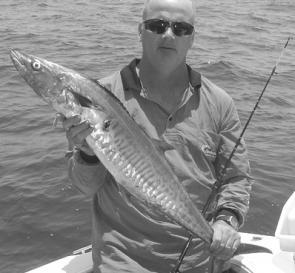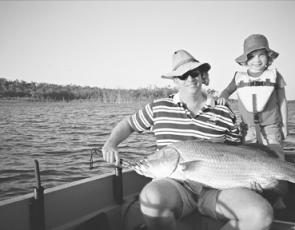The Rock Cod Shoals featured in many reports last month with some big hits of red-throat sweetlip. If the same light northeast breezes in the morning with afternoon inshore winds of 15-20 knots continue, February should be equally productive.
My mate Brian Green and I had a trip to the shoals early in the morning. We headed out before sunrise but the conditions on the way out and at the shoals were a little sloppier than we had hoped. The prevailing northeast winds can sometimes make conditions uncomfortable so we decided to drift rather than anchor up. The preferred bottom set-up up in these conditions is a paternoster rig and two twisted dropper loops, the first 30-40cm above the snapper lead with the top loop about 50-60cm above the first loop.
Making the twisted dropper loop involves twisting the line so a loop spirals outward. Follow these steps:
1. Isolate the spiral by crossing the line from each side to form a loop.
2. Put your index fingers between the loop and the tag.
3. Twist the crossover making half twists.
4. Having completed 6-8 twists, pass the loop spiral through the cross-over gap.
5. Close the knot with firm pressure [For further info and illustrations on how to tie this knot I recommend consulting Jeff Wilson’s Complete Book of Knots & Rigs – Ed].
I use squid on my bottom hooks as it tends to better handle the effects of the pickers before bigger fish are attracted to the commotion around the hooks. There is usually enough bait left to warrant further inspection and achieve subsequent hook-ups. That’s the theory, anyway!
We set a couple of floaters with an unweighted pilchard on three ganged 5/0 hooks, waiting for a summer mackerel to hook up. Our bottom rigs got a workout but our floaters were bringing home the bacon on this trip.
We had only just set a small berley trail when the line was stripped from Greenie’s line. Greenie was fishing with a nylon leader and I was using a stainless steel trace. Greenie played the fish skilfully and brought a quality Spanish mackerel to the side of the boat.
I was on gaff duty so when the first sweep of the hook missed the fish and caught onto Greenie’s line my heart stopped but luckily so did the Spaniard, long enough for a second and more successful attempt. The mackerel was safely in the boat due more to good luck than good technique.
The next hook-up on the floater was a quality red-throat sweetlip. Red-throat normally travel in shoals at depth as they sweep across the reef areas on hunting expeditions. They can be berleyed up to attack a floating pilchard and are tough on the surface. Any run from here is usually downward. Strange as it may seem, on the last couple of trips we have caught more red-throat on our floating baits than on bottom rigs. This technique is becoming increasingly more productive with each trip to these shoals.
For some reason, the shallow western parts of these shoals give up better quality fish during the warmer months than the deeper eastern sections. I head for my favourite mark at 23.41.745S + 151.36.340E which puts me in the middle of the shoals shallow section. I can then drift in any direction and stay within good structure most of the time. Once the speed and direction is clear, you can change the starting location of subsequent drifts.
The denser structure seems to be located in depths from 8-15m. There are some very impressive bommies outside of these depths but they seem to be distinct and separated from the general coral floor. It’s usually more productive to anchor on these structures.
Spotted and Spanish mackerel are appearing around most of the reefs this summer. They seem to run regularly through Rodd Harbour along the channel formed at Tongue Spit.
Rodd Harbour can be accessed using Turkey Beach’s excellent boat ramps only 45 minutes by car from Gladstone. If weather conditions are good, it’s an easy boat run from Gladstone Harbour that takes 45-90 minutes depending on conditions.
Spotted mackerel attack trolled spoons and baits with ferocity. They’re one of the best sporting fish around, with frequent runs even to the bitter end.
When you’ve had your fill of Rodd Harbour mackerel, travel to nearby Richard Point and work baits towards Elephant Rocks for sweetlip, parrot or cod. Blackalls (mother-in-laws) also frequent these areas and whilst they aren’t favoured as a tablefish they can be used in fish dishes for a stronger flavour. The larger species are worthy opponents who will struggle all the way to the boat even though they are not known for big runs.
Some decent flathead are still around. Flathead tend to be more aggressive in the warmer months but the bigger species are usually found around the cooler months of July-September. Karen proved there are exceptions to every rule when she pulled a big lizard from the waters of Rodd Harbour.
The warmer months have brought some big barra to the surface at Awoonga Dam. It’s the flavour of the month with hundreds of locals and visitors testing out the waters each week and often each day. The big barra just keep on coming! Pig and Inveragh creeks feature in local reports. The new campsite at Boynedale provides easy access to the dam and is a popular location, so expect crowds during the holidays and long weekends.
Watch for weather conditions and give Rock Cod Shoals some further consideration. It’s still one of Gladstone’s most consistently productive areas but you will need a boat of 5m or more to be safe. Summer storms frequent this area and smaller boats can get into trouble.
Try an early morning expedition and get home before the midday inshore breeze change. To make the boat trip more comfortable, follow the water when travelling to and returning from the shoals.
Trees Inlet is still my favoured estuary location at this time of year as it provides many fishing opportunities. Mangrove drains are great locations to target but the mangrove-lined estuaries will often give up good jacks. It’s worth trolling hard-bodied lures along the mangrove edges.
I am also hoping to fit in a Yellow Patch overnighter. It is a top Gladstone camping and fishing location within easy reach of Bass Shoals and Rundle Island. With whiting at your tent flap, how can you go wrong?
Reads: 6046






